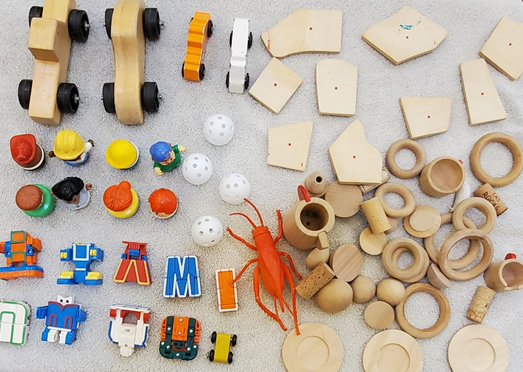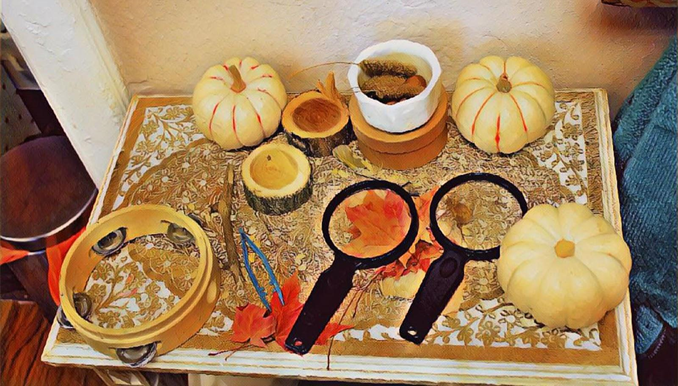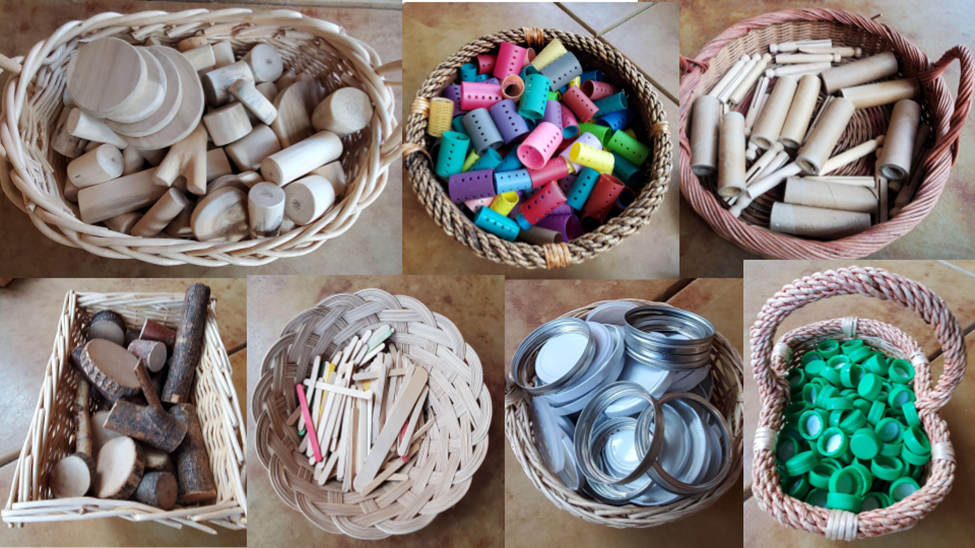10.5: Materials that Support Cognitive Development
- Page ID
- 139906
Materials and Cognitive Development
Jean Piaget’s theory of cognitive development proposed a pivotal connection between experiences and cognitive development during the sensorimotor stage of infancy and toddlerhood. The sensorimotor period begins at birth and continues through the child’s first two years. During this stage, infants and toddlers experience the world through sensation (sensory) and movement (motor). Materials can stimulate both sensory and motor experiences and therefore are an important way to support the cognitive development of infants and toddlers. [1]
To encourage exploration, the selection of materials provided to infants and toddlers should be age-appropriate and based on what caregivers observe them to be interested in. As infants age, their strategies for exploring materials changes. For example, mouthing is a predominant form of exploration at 6 months of age but is exchanged for more refined forms of manual exploration later in infancy (Kaur, Srinivasan & Bhat, 2015). Another example can be seen in the developmental changes in grasping ability. Infants improve their grasping abilities between 6 and 15 months of age (Butterworth, Verweij & Hopkins, 1997). Similarly, 12 to 14 month old infants show appropriate, anticipatory changes in grasp formation based on object shape and size compared to 5 to 6 month old infants (Barrett et al., 2008; Fagard, 2000). Infants with more advanced motor abilities (i.e., those who could crawl, stand, or walk) are more interested in objects with handles (Nelson & Oakes, 2021). Based on this research, caregivers should observe the developmental changes of infants and toddlers, such as exploration and grasping strategies, and provide materials that continue to challenge, intrigue and support their age-appropriate developing abilities. For example, consider the collection of play materials in Figure \(\PageIndex{1}\). How might the different developing grasping abilities of infants and toddlers influence how they are able to hold, manipulate and explore the various materials? [1]

Along with age-appropriateness, exploratory behaviors are also influenced by material properties including size, shape, texture, and weight of objects (Barrett et al., 2008; Bourgeois et al., 2005; Corbetta & Snapp-Childs, 2009; Libertus et al., 2013; Newell et al., 1989, 1993; van Hof et al., 2002). For example, infants showed greater grasping of smaller objects whereas they looked more at larger objects (Rochat, 1989). In addition, 9 to 12 month old infants explored object properties such as shape, size, and texture by rotating, fingering, and transferring objects, whereas they explored properties such as weight, sound, and rigidity by banging and shaking objects (Ruff, 1984). Infants’ grasping patterns depended on object size and structure as smaller objects were grasped with one hand and larger objects were grasped with two hands (Kaur, Srinivasan & Bhat, 2015). Similarly, infants squeezed non-rigid objects more compared to rigid objects (Barrett et al., 2008; Newell et al., 1989, 1993). This research suggests that caregivers should constantly be observing the developing abilities of infants and toddlers and providing age-appropriate materials based on these close observations. [2]
Loose Parts
Loose parts refers to materials that are open-ended and manipulable (Nicholson, 1971). Loose parts are moveable, non-dictated materials that children can use in a variety of ways (Daly & Beloglovsky, 2015; Maxwell, Mitchell, & Evans, 2008). Loose parts are often considered in contrast to pre-designed toys, like most toys sold at stores. For example, a toy airplane, if provided to a child, will probably be used in a limited number of ways, limited to what the toy is, an airplane. In contrast, materials such as leaves and popsicle sticks affords creative engagement with unlimited ways to interact with the materials. Figure \(\PageIndex{2}\) is a picture of a loose parts table with various objects from nature: small pumpkins, leaves, slices of trunk from a small tree, sticks, etc., and tools like tweezers and magnifying glasses, to support further exploration. Take a moment to look over the objects and tools in Figure \(\PageIndex{2}\), then consider these questions: [4]
- What do you imagine toddlers doing while at the table?
- How many different ways of using the materials can you imagine for toddlers?
- How do the carefully selected tools (twissors, magnify glasses) further support exploration than would probably happen if the tools were not present?
- What other tools could be added?
- What cognitive concepts are toddlers experiencing as they engage with the materials?

When children have exposure to intriguing loose parts, they become curious. Children’s curiosity is triggered when they see and experience new things and have unique experiences that may not be otherwise possible in the indoor environment. This sense of curiosity is how children become inspired to engage in new explorations and discoveries (Perry, 2004). Loose parts give children the freedom to develop their play experiences based on their personal ideas and goals, rather than the play being predetermined by the materials or surroundings (Änggård, 2011). This means that the materials do not dictate the type of play children engage in. Children create play episodes based on their past experiences, curiosity, creativity, and new ideas. [4]

[1] Scott & Cogburn (2021). Piaget. StatPearls Publishing. CC by 4.0
[2] Kaur et al., (2015). Atypical object exploration in infants at-risk for autism during the first year of life. Frontiers in Psychology, 6, 798. CC by 4.0
[3] Image by Todd LaMarr is licensed under CC by 4.0
[4] Flannigan & Dietze (2017). Children, outdoor play, and loose parts. Journal of Childhood Studies, 53-60. CC by NC 4.0
[5] Image from Susan Lewis-Penix on Unsplash.
[6] Loose parts by Todd LaMarr is licensed under CC by 4.0

